当前位置:网站首页>Bluebridge cup internet of things competition basic graphic tutorial - clock selection
Bluebridge cup internet of things competition basic graphic tutorial - clock selection
2022-07-05 08:23:00 【IOT Xiaokai】
Bluebridge cup internet of things competition basic graphic tutorial —— Clock selection
1 What is a clock
Clock is the basis of MCU operation , The clock signal pushes each part of the MCU to execute the corresponding instructions . The clock system is CPU The pulse of , decision cpu rate , Like a human heartbeat Only with a heartbeat , People can do other things , And MCU has a clock , To run and execute instructions , Can do other processing ( Lighting , A serial port ,ADC), The importance of the clock is self-evident .
Why? STM32 There should be multiple clock sources ?
STM32 It's very complicated , There are many peripherals But when we actually use it, we only use a limited number of peripherals , Using any peripheral requires a clock to start ,** But not all peripherals need the high frequency of the system clock , In order to be compatible with devices with different speeds , Some high speed , Some low speed , If you use a high-speed clock , It is bound to cause waste also , The same circuit , The faster the clock, the faster the power consumption , At the same time, the ability to resist electromagnetic interference is weaker , So the more complicated MCU They all use the method of multi clock source to solve these problems .** So there is STM32 Clock system and clock tree
blanket :
STM32 The main purpose of clock system is to provide clock for relatively independent peripheral modules , It is also to reduce the energy consumption of the whole chip .
The system clock , Is the processor runtime benchmark ( One clock cycle per machine instruction )
Clock is the basis of MCU operation , The clock signal pushes each part of the MCU to execute the corresponding instructions .
A single chip microcomputer provides multiple different system clocks , Can adapt to more applications .
Different function modules have different clock upper limits , Therefore, different clocks are provided , More functional modules can also be placed in a single chip microcomputer .
Add on and off functions for clocks of different modules , It can reduce the power consumption of MCU
STM32 For low power consumption , He set all peripheral clocks to disable( Do not enable ), What peripherals are used , Just turn on the clock of the corresponding peripheral , Other unused items can still be disable( Do not enable ), This will reduce energy consumption . This is why no matter what function you configure, you need to turn on the corresponding clock first 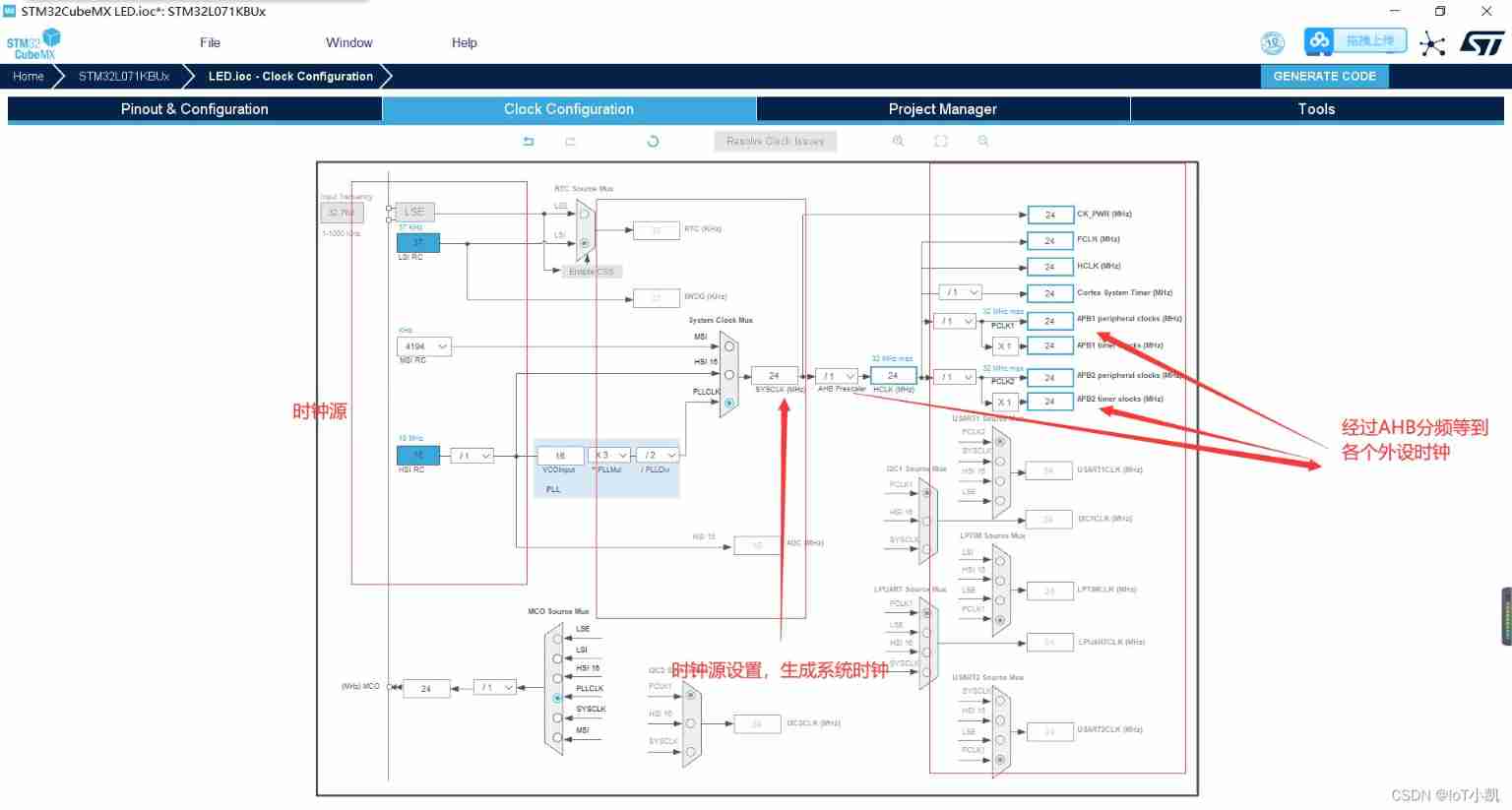
Let's look at the system clock SYSCLK Left side There are many options for the system clock , The left part is to set the system clock to use the clock source ,
The system clock SYSCLK To the right of , The system clock passes AHB Preassigned frequency counter , Set the corresponding clock frequency for the corresponding peripheral 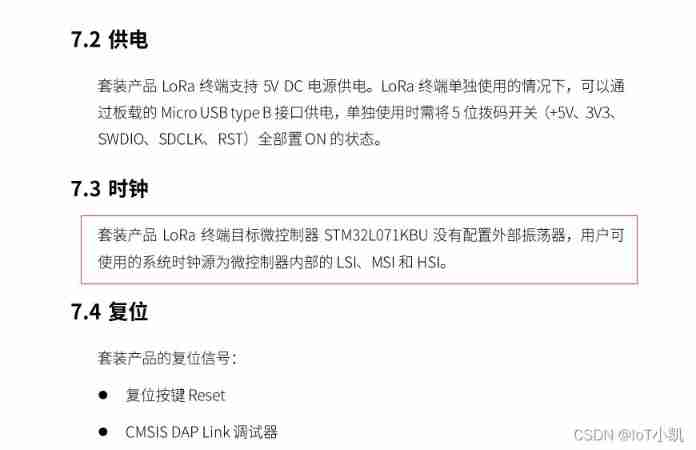
This development board has no external clock source , To do this, only select the setting for the internal clock source
First choose PLL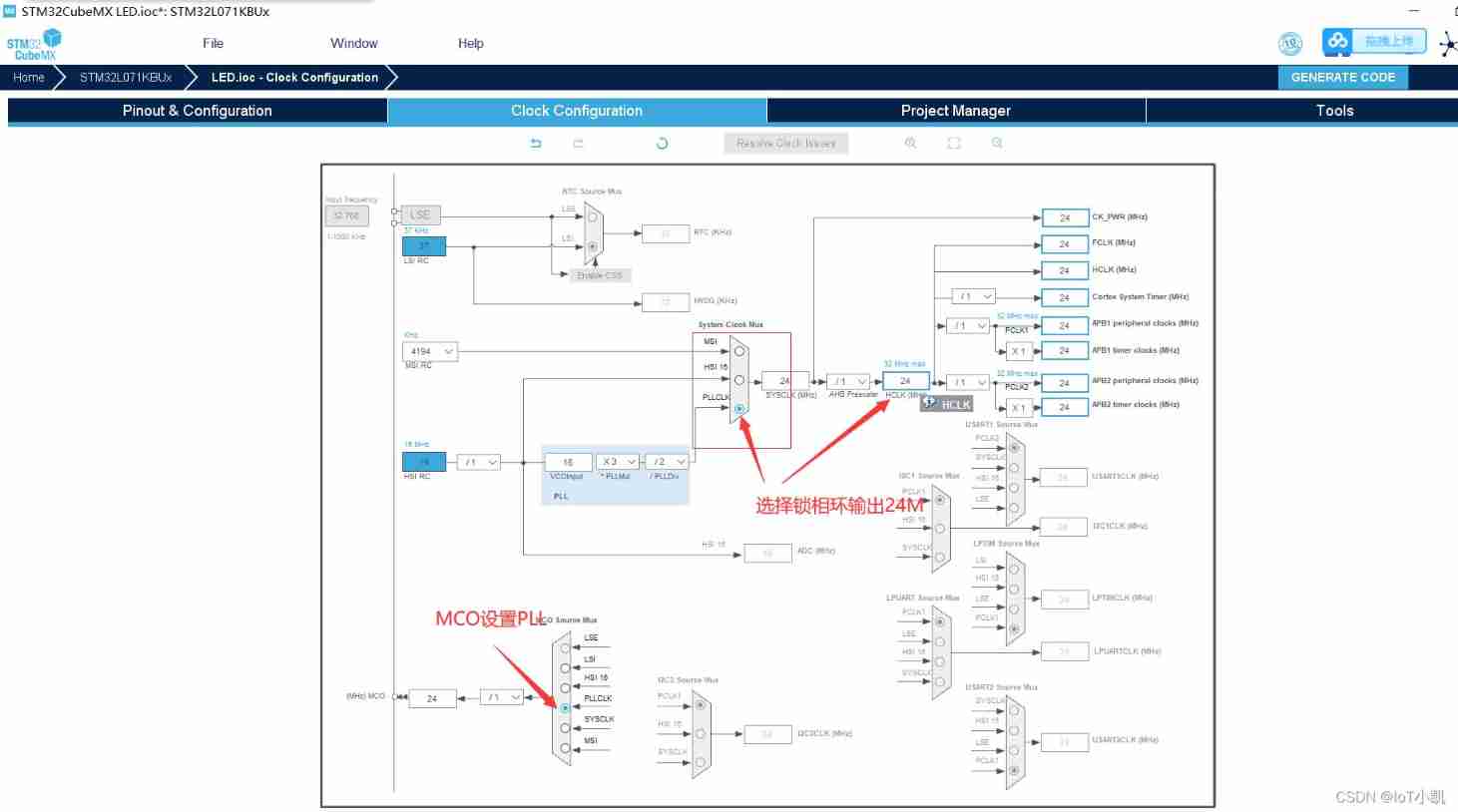
The generated code
void SystemClock_Config(void)
{
RCC_OscInitTypeDef RCC_OscInitStruct = {
0};
RCC_ClkInitTypeDef RCC_ClkInitStruct = {
0};
/** Configure the main internal regulator output voltage */
__HAL_PWR_VOLTAGESCALING_CONFIG(PWR_REGULATOR_VOLTAGE_SCALE1);
/** Initializes the RCC Oscillators according to the specified parameters * in the RCC_OscInitTypeDef structure. */
RCC_OscInitStruct.OscillatorType = RCC_OSCILLATORTYPE_HSI;
RCC_OscInitStruct.HSIState = RCC_HSI_ON;
RCC_OscInitStruct.HSICalibrationValue = RCC_HSICALIBRATION_DEFAULT;
RCC_OscInitStruct.PLL.PLLState = RCC_PLL_ON;
RCC_OscInitStruct.PLL.PLLSource = RCC_PLLSOURCE_HSI;
RCC_OscInitStruct.PLL.PLLMUL = RCC_PLLMUL_3;
RCC_OscInitStruct.PLL.PLLDIV = RCC_PLLDIV_2;
if (HAL_RCC_OscConfig(&RCC_OscInitStruct) != HAL_OK)
{
Error_Handler();
}
/** Initializes the CPU, AHB and APB buses clocks */
RCC_ClkInitStruct.ClockType = RCC_CLOCKTYPE_HCLK|RCC_CLOCKTYPE_SYSCLK
|RCC_CLOCKTYPE_PCLK1|RCC_CLOCKTYPE_PCLK2;
RCC_ClkInitStruct.SYSCLKSource = RCC_SYSCLKSOURCE_PLLCLK;
RCC_ClkInitStruct.AHBCLKDivider = RCC_SYSCLK_DIV1;
RCC_ClkInitStruct.APB1CLKDivider = RCC_HCLK_DIV1;
RCC_ClkInitStruct.APB2CLKDivider = RCC_HCLK_DIV1;
if (HAL_RCC_ClockConfig(&RCC_ClkInitStruct, FLASH_LATENCY_1) != HAL_OK)
{
Error_Handler();
}
}
choice HSI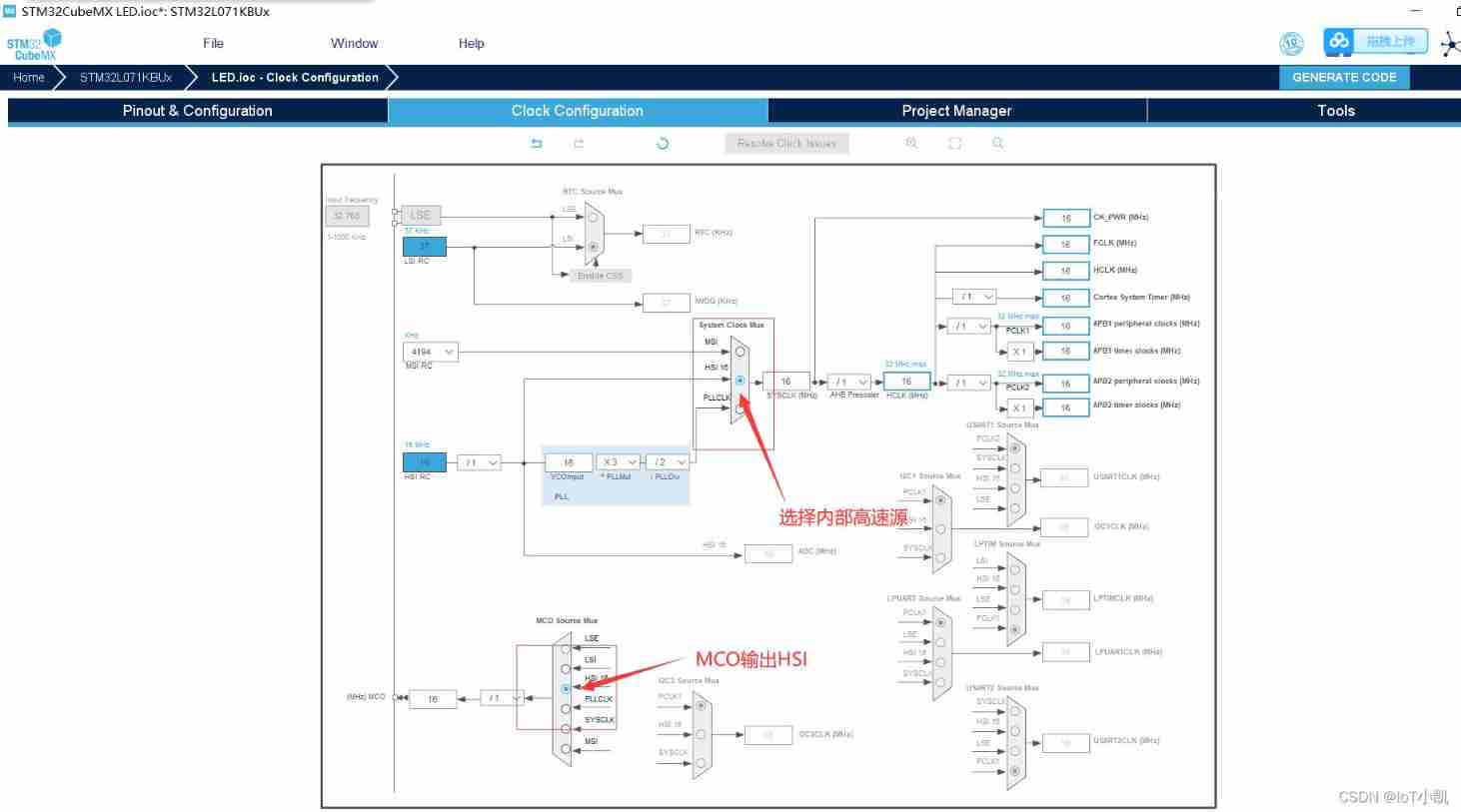
The generated code , Select different clock sources for , to HSI16M The clock source setting function is named SystemClock_HSI16M_Config To distinguish
void SystemClock_HSI16M_Config(void)
{
RCC_OscInitTypeDef RCC_OscInitStruct = {
0};
RCC_ClkInitTypeDef RCC_ClkInitStruct = {
0};
/** Configure the main internal regulator output voltage */
__HAL_PWR_VOLTAGESCALING_CONFIG(PWR_REGULATOR_VOLTAGE_SCALE1);
/** Initializes the CPU, AHB and APB busses clocks */
RCC_OscInitStruct.OscillatorType = RCC_OSCILLATORTYPE_HSI;
RCC_OscInitStruct.HSIState = RCC_HSI_ON;
RCC_OscInitStruct.HSICalibrationValue = RCC_HSICALIBRATION_DEFAULT;
RCC_OscInitStruct.PLL.PLLState = RCC_PLL_NONE;
if (HAL_RCC_OscConfig(&RCC_OscInitStruct) != HAL_OK)
{
Error_Handler();
}
/** Initializes the CPU, AHB and APB busses clocks */
RCC_ClkInitStruct.ClockType = RCC_CLOCKTYPE_HCLK | RCC_CLOCKTYPE_SYSCLK
| RCC_CLOCKTYPE_PCLK1 | RCC_CLOCKTYPE_PCLK2;
RCC_ClkInitStruct.SYSCLKSource = RCC_SYSCLKSOURCE_HSI;
RCC_ClkInitStruct.AHBCLKDivider = RCC_SYSCLK_DIV1;
RCC_ClkInitStruct.APB1CLKDivider = RCC_HCLK_DIV1;
RCC_ClkInitStruct.APB2CLKDivider = RCC_HCLK_DIV1;
if (HAL_RCC_ClockConfig(&RCC_ClkInitStruct, FLASH_LATENCY_0) != HAL_OK)
{
Error_Handler();
}
HAL_RCC_MCOConfig(RCC_MCO1, RCC_MCO1SOURCE_HSI, RCC_MCODIV_1);
}
choice MSI Clock source 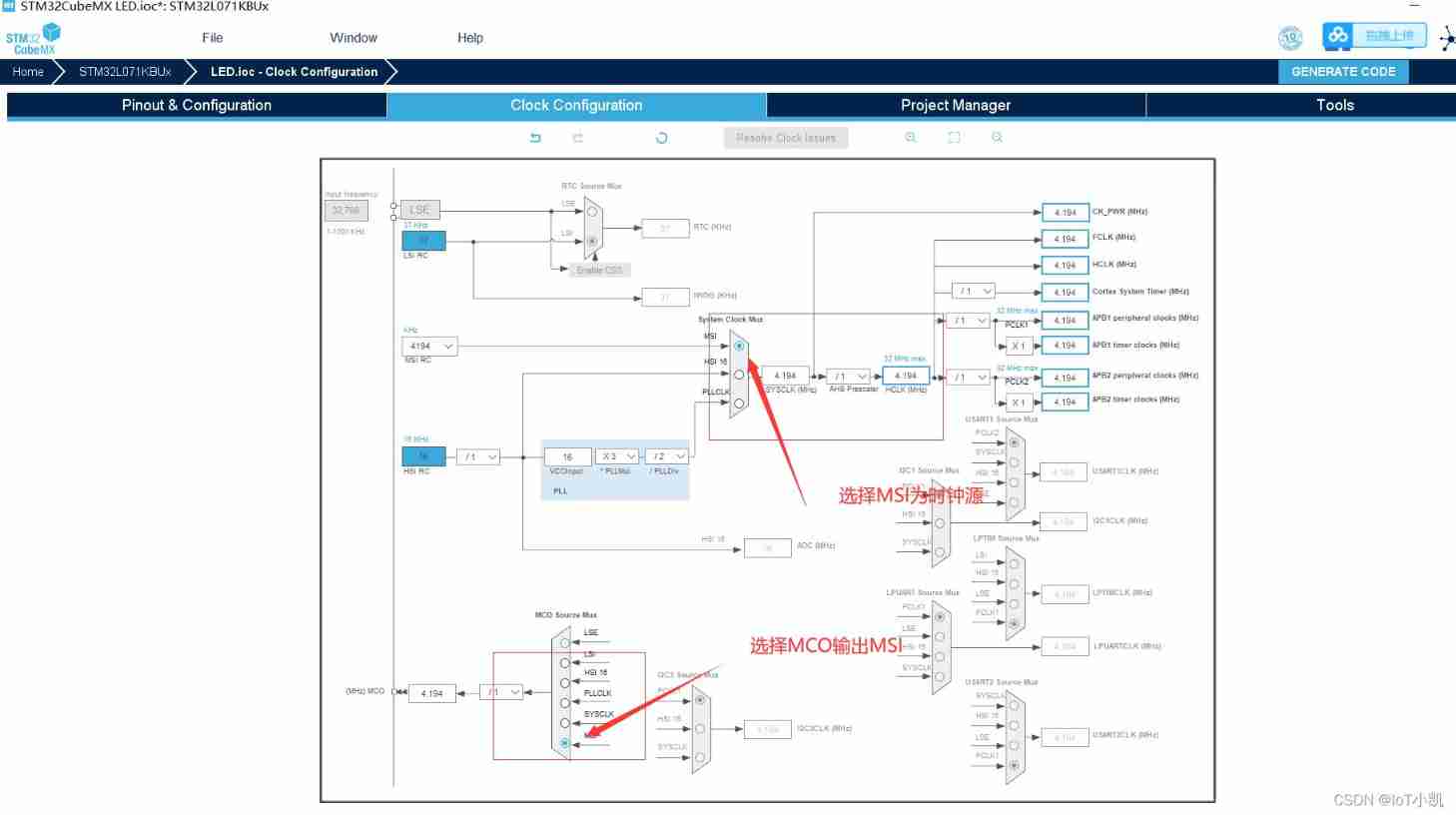
The generated code , Select different clock sources for , to MSI 4M The clock source setting function is named SystemClock_MSI4M_Config To distinguish
void SystemClock_MSI4M_Config(void)
{
RCC_OscInitTypeDef RCC_OscInitStruct = {
0};
RCC_ClkInitTypeDef RCC_ClkInitStruct = {
0};
/** Configure the main internal regulator output voltage */
__HAL_PWR_VOLTAGESCALING_CONFIG(PWR_REGULATOR_VOLTAGE_SCALE1);
/** Initializes the CPU, AHB and APB busses clocks */
RCC_OscInitStruct.OscillatorType = RCC_OSCILLATORTYPE_MSI;
RCC_OscInitStruct.MSIState = RCC_MSI_ON;
RCC_OscInitStruct.MSICalibrationValue = 0;
RCC_OscInitStruct.MSIClockRange = RCC_MSIRANGE_6;
RCC_OscInitStruct.PLL.PLLState = RCC_PLL_NONE;
if (HAL_RCC_OscConfig(&RCC_OscInitStruct) != HAL_OK)
{
Error_Handler();
}
/** Initializes the CPU, AHB and APB busses clocks */
RCC_ClkInitStruct.ClockType = RCC_CLOCKTYPE_HCLK | RCC_CLOCKTYPE_SYSCLK
| RCC_CLOCKTYPE_PCLK1 | RCC_CLOCKTYPE_PCLK2;
RCC_ClkInitStruct.SYSCLKSource = RCC_SYSCLKSOURCE_MSI;
RCC_ClkInitStruct.AHBCLKDivider = RCC_SYSCLK_DIV1;
RCC_ClkInitStruct.APB1CLKDivider = RCC_HCLK_DIV1;
RCC_ClkInitStruct.APB2CLKDivider = RCC_HCLK_DIV1;
if (HAL_RCC_ClockConfig(&RCC_ClkInitStruct, FLASH_LATENCY_0) != HAL_OK)
{
Error_Handler();
}
HAL_RCC_MCOConfig(RCC_MCO1, RCC_MCO1SOURCE_MSI, RCC_MCODIV_1);
}
Detailed clock tree introduction reference article
RCC——MCO Output PA8 Pin ( If there is an oscilloscope , When the key is pressed , Can be PA8 Output the pin to the oscilloscope to observe the frequency change , Because there is no oscilloscope , Is not showing PA8 Output )
STM32F Series of boards can simulate the output PA8 Pin , stay MDK Observation can be set on PA8 Pin frequency , But I found after searching the settings STM32L It seems that the series of boards cannot be simulated ( If there is a big guy who is right, please give advice in the comment area )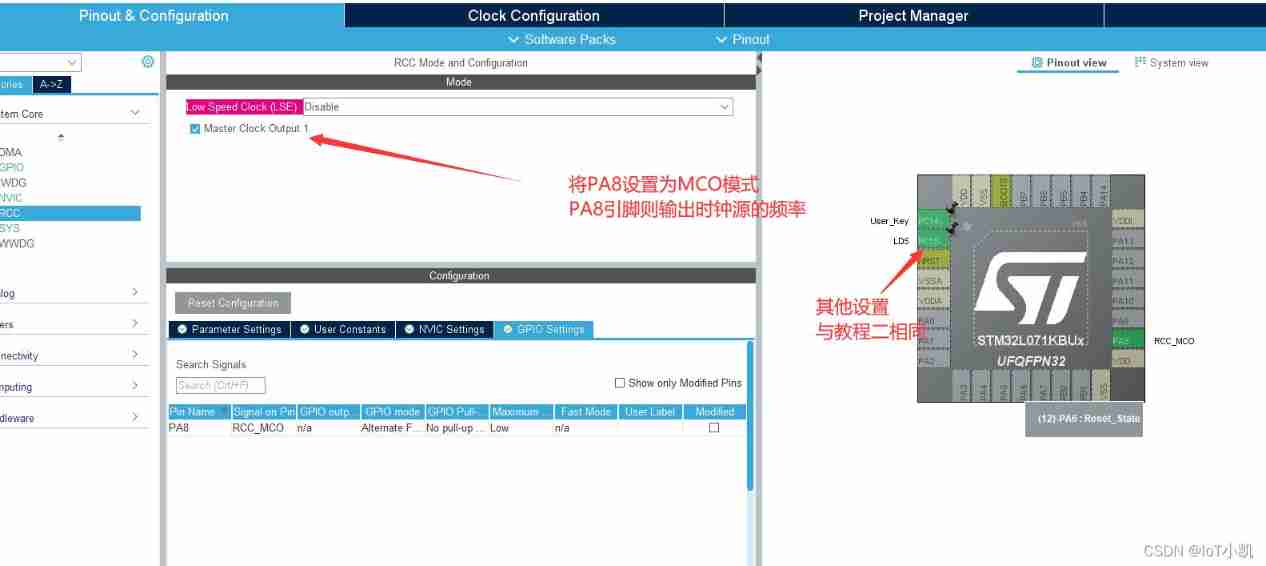
But we can observe the frequency change in another way , Observe LD5 The frequency of flickering
main.c Code 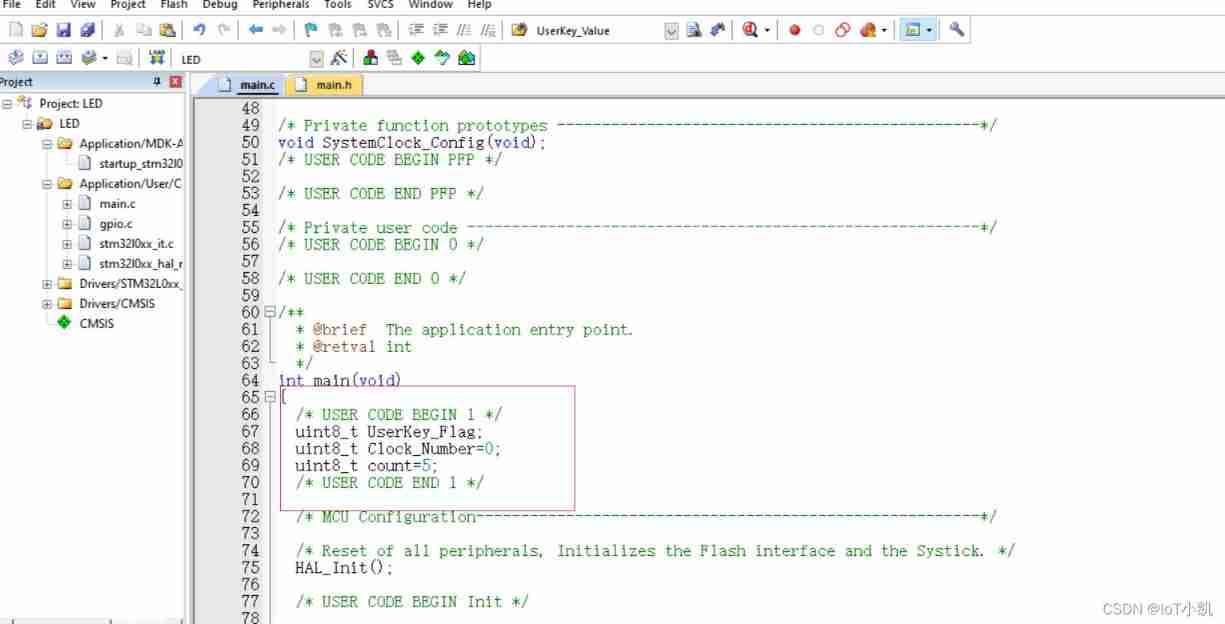
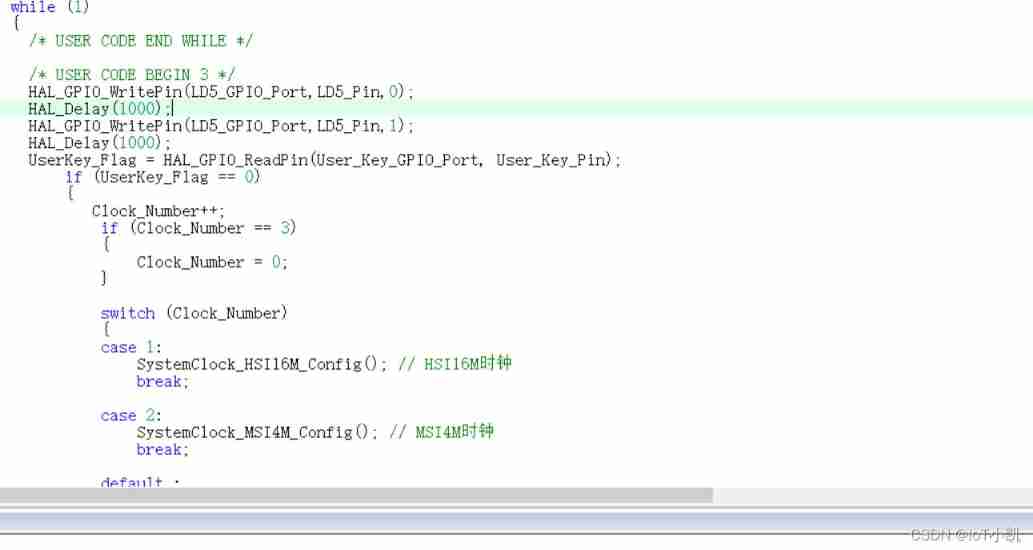
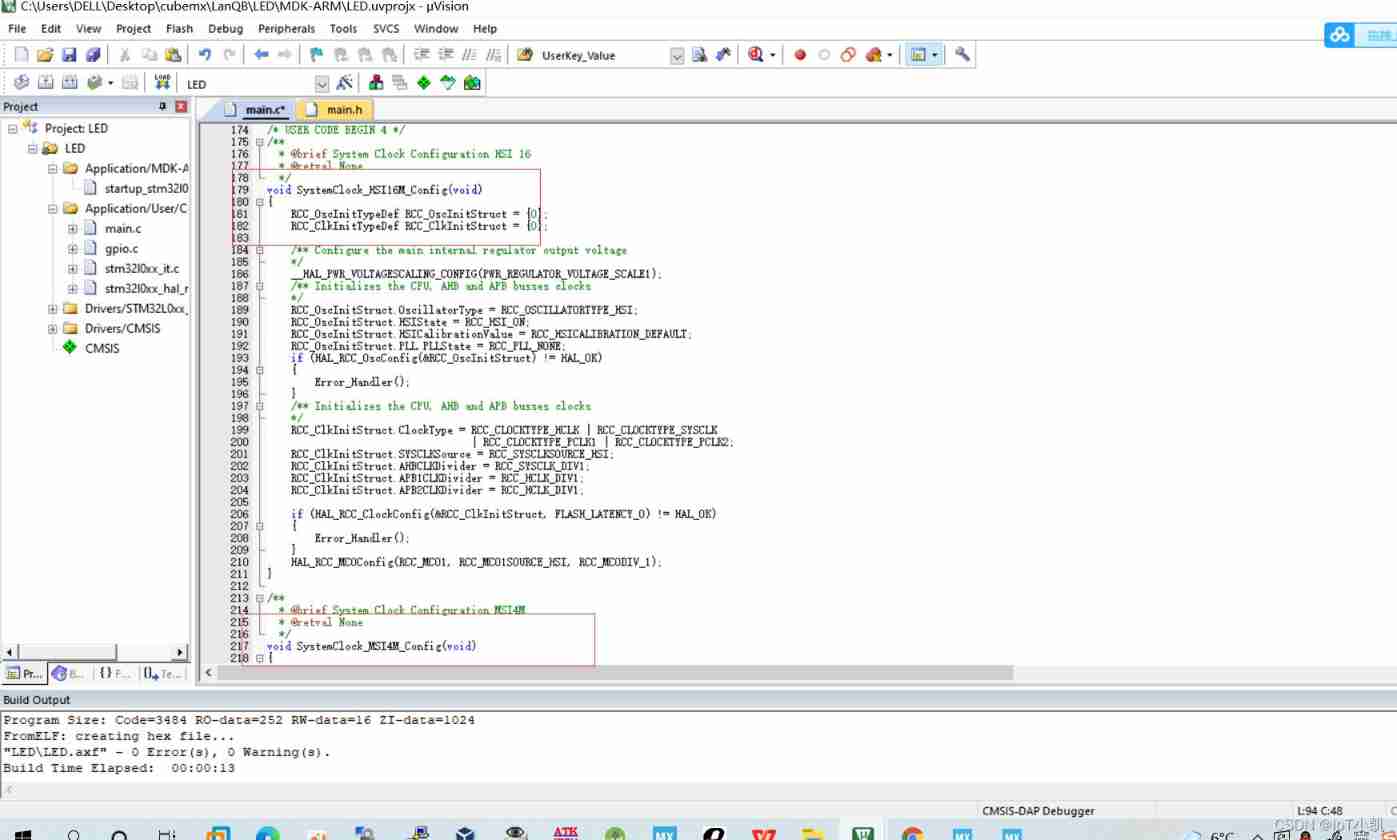
/* USER CODE BEGIN Header */
/** ****************************************************************************** * @file : main.c * @brief : Main program body ****************************************************************************** * @attention * * <h2><center>© Copyright (c) 2022 STMicroelectronics. * All rights reserved.</center></h2> * * This software component is licensed by ST under BSD 3-Clause license, * the "License"; You may not use this file except in compliance with the * License. You may obtain a copy of the License at: * opensource.org/licenses/BSD-3-Clause * ****************************************************************************** */
/* USER CODE END Header */
/* Includes ------------------------------------------------------------------*/
#include "main.h"
#include "gpio.h"
/* Private includes ----------------------------------------------------------*/
/* USER CODE BEGIN Includes */
/* USER CODE END Includes */
/* Private typedef -----------------------------------------------------------*/
/* USER CODE BEGIN PTD */
/* USER CODE END PTD */
/* Private define ------------------------------------------------------------*/
/* USER CODE BEGIN PD */
/* USER CODE END PD */
/* Private macro -------------------------------------------------------------*/
/* USER CODE BEGIN PM */
/* USER CODE END PM */
/* Private variables ---------------------------------------------------------*/
/* USER CODE BEGIN PV */
/* USER CODE END PV */
/* Private function prototypes -----------------------------------------------*/
void SystemClock_Config(void);
/* USER CODE BEGIN PFP */
/* USER CODE END PFP */
/* Private user code ---------------------------------------------------------*/
/* USER CODE BEGIN 0 */
/* USER CODE END 0 */
/** * @brief The application entry point. * @retval int */
int main(void)
{
/* USER CODE BEGIN 1 */
uint8_t UserKey_Flag;
uint8_t Clock_Number=0;
uint8_t count=5;
/* USER CODE END 1 */
/* MCU Configuration--------------------------------------------------------*/
/* Reset of all peripherals, Initializes the Flash interface and the Systick. */
HAL_Init();
/* USER CODE BEGIN Init */
/* USER CODE END Init */
/* Configure the system clock */
SystemClock_Config();
/* USER CODE BEGIN SysInit */
/* USER CODE END SysInit */
/* Initialize all configured peripherals */
MX_GPIO_Init();
/* USER CODE BEGIN 2 */
/* USER CODE END 2 */
/* Infinite loop */
/* USER CODE BEGIN WHILE */
while (1)
{
/* USER CODE END WHILE */
/* USER CODE BEGIN 3 */
HAL_GPIO_WritePin(LD5_GPIO_Port,LD5_Pin,0);
HAL_Delay(1000);
HAL_GPIO_WritePin(LD5_GPIO_Port,LD5_Pin,1);
HAL_Delay(1000);
UserKey_Flag = HAL_GPIO_ReadPin(User_Key_GPIO_Port, User_Key_Pin);
if (UserKey_Flag == 0)
{
Clock_Number++;
if (Clock_Number == 3)
{
Clock_Number = 0;
}
switch (Clock_Number)
{
case 1:
SystemClock_HSI16M_Config(); // HSI16M The clock
break;
case 2:
SystemClock_MSI4M_Config(); // MSI4M The clock
break;
default :
SystemClock_Config(); // PLL24M The clock
break;
}
}
}
/* USER CODE END 3 */
}
/** * @brief System Clock Configuration * @retval None */
void SystemClock_Config(void)
{
RCC_OscInitTypeDef RCC_OscInitStruct = {
0};
RCC_ClkInitTypeDef RCC_ClkInitStruct = {
0};
/** Configure the main internal regulator output voltage */
__HAL_PWR_VOLTAGESCALING_CONFIG(PWR_REGULATOR_VOLTAGE_SCALE1);
/** Initializes the RCC Oscillators according to the specified parameters * in the RCC_OscInitTypeDef structure. */
RCC_OscInitStruct.OscillatorType = RCC_OSCILLATORTYPE_HSI;
RCC_OscInitStruct.HSIState = RCC_HSI_ON;
RCC_OscInitStruct.HSICalibrationValue = RCC_HSICALIBRATION_DEFAULT;
RCC_OscInitStruct.PLL.PLLState = RCC_PLL_NONE;
if (HAL_RCC_OscConfig(&RCC_OscInitStruct) != HAL_OK)
{
Error_Handler();
}
/** Initializes the CPU, AHB and APB buses clocks */
RCC_ClkInitStruct.ClockType = RCC_CLOCKTYPE_HCLK|RCC_CLOCKTYPE_SYSCLK
|RCC_CLOCKTYPE_PCLK1|RCC_CLOCKTYPE_PCLK2;
RCC_ClkInitStruct.SYSCLKSource = RCC_SYSCLKSOURCE_HSI;
RCC_ClkInitStruct.AHBCLKDivider = RCC_SYSCLK_DIV1;
RCC_ClkInitStruct.APB1CLKDivider = RCC_HCLK_DIV1;
RCC_ClkInitStruct.APB2CLKDivider = RCC_HCLK_DIV1;
if (HAL_RCC_ClockConfig(&RCC_ClkInitStruct, FLASH_LATENCY_0) != HAL_OK)
{
Error_Handler();
}
HAL_RCC_MCOConfig(RCC_MCO1, RCC_MCO1SOURCE_HSI, RCC_MCODIV_1);
}
/* USER CODE BEGIN 4 */
/** * @brief System Clock Configuration HSI 16 * @retval None */
void SystemClock_HSI16M_Config(void)
{
RCC_OscInitTypeDef RCC_OscInitStruct = {
0};
RCC_ClkInitTypeDef RCC_ClkInitStruct = {
0};
/** Configure the main internal regulator output voltage */
__HAL_PWR_VOLTAGESCALING_CONFIG(PWR_REGULATOR_VOLTAGE_SCALE1);
/** Initializes the CPU, AHB and APB busses clocks */
RCC_OscInitStruct.OscillatorType = RCC_OSCILLATORTYPE_HSI;
RCC_OscInitStruct.HSIState = RCC_HSI_ON;
RCC_OscInitStruct.HSICalibrationValue = RCC_HSICALIBRATION_DEFAULT;
RCC_OscInitStruct.PLL.PLLState = RCC_PLL_NONE;
if (HAL_RCC_OscConfig(&RCC_OscInitStruct) != HAL_OK)
{
Error_Handler();
}
/** Initializes the CPU, AHB and APB busses clocks */
RCC_ClkInitStruct.ClockType = RCC_CLOCKTYPE_HCLK | RCC_CLOCKTYPE_SYSCLK
| RCC_CLOCKTYPE_PCLK1 | RCC_CLOCKTYPE_PCLK2;
RCC_ClkInitStruct.SYSCLKSource = RCC_SYSCLKSOURCE_HSI;
RCC_ClkInitStruct.AHBCLKDivider = RCC_SYSCLK_DIV1;
RCC_ClkInitStruct.APB1CLKDivider = RCC_HCLK_DIV1;
RCC_ClkInitStruct.APB2CLKDivider = RCC_HCLK_DIV1;
if (HAL_RCC_ClockConfig(&RCC_ClkInitStruct, FLASH_LATENCY_0) != HAL_OK)
{
Error_Handler();
}
HAL_RCC_MCOConfig(RCC_MCO1, RCC_MCO1SOURCE_HSI, RCC_MCODIV_1);
}
/** * @brief System Clock Configuration MSI4M * @retval None */
void SystemClock_MSI4M_Config(void)
{
RCC_OscInitTypeDef RCC_OscInitStruct = {
0};
RCC_ClkInitTypeDef RCC_ClkInitStruct = {
0};
/** Configure the main internal regulator output voltage */
__HAL_PWR_VOLTAGESCALING_CONFIG(PWR_REGULATOR_VOLTAGE_SCALE1);
/** Initializes the CPU, AHB and APB busses clocks */
RCC_OscInitStruct.OscillatorType = RCC_OSCILLATORTYPE_MSI;
RCC_OscInitStruct.MSIState = RCC_MSI_ON;
RCC_OscInitStruct.MSICalibrationValue = 0;
RCC_OscInitStruct.MSIClockRange = RCC_MSIRANGE_6;
RCC_OscInitStruct.PLL.PLLState = RCC_PLL_NONE;
if (HAL_RCC_OscConfig(&RCC_OscInitStruct) != HAL_OK)
{
Error_Handler();
}
/** Initializes the CPU, AHB and APB busses clocks */
RCC_ClkInitStruct.ClockType = RCC_CLOCKTYPE_HCLK | RCC_CLOCKTYPE_SYSCLK
| RCC_CLOCKTYPE_PCLK1 | RCC_CLOCKTYPE_PCLK2;
RCC_ClkInitStruct.SYSCLKSource = RCC_SYSCLKSOURCE_MSI;
RCC_ClkInitStruct.AHBCLKDivider = RCC_SYSCLK_DIV1;
RCC_ClkInitStruct.APB1CLKDivider = RCC_HCLK_DIV1;
RCC_ClkInitStruct.APB2CLKDivider = RCC_HCLK_DIV1;
if (HAL_RCC_ClockConfig(&RCC_ClkInitStruct, FLASH_LATENCY_0) != HAL_OK)
{
Error_Handler();
}
HAL_RCC_MCOConfig(RCC_MCO1, RCC_MCO1SOURCE_MSI, RCC_MCODIV_1);
}
/* USER CODE END 4 */
/** * @brief This function is executed in case of error occurrence. * @retval None */
void Error_Handler(void)
{
/* USER CODE BEGIN Error_Handler_Debug */
/* User can add his own implementation to report the HAL error return state */
__disable_irq();
while (1)
{
}
/* USER CODE END Error_Handler_Debug */
}
#ifdef USE_FULL_ASSERT
/** * @brief Reports the name of the source file and the source line number * where the assert_param error has occurred. * @param file: pointer to the source file name * @param line: assert_param error line source number * @retval None */
void assert_failed(uint8_t *file, uint32_t line)
{
/* USER CODE BEGIN 6 */
/* User can add his own implementation to report the file name and line number, ex: printf("Wrong parameters value: file %s on line %d\r\n", file, line) */
/* USER CODE END 6 */
}
#endif /* USE_FULL_ASSERT */
/************************ (C) COPYRIGHT STMicroelectronics *****END OF FILE****/
main.h Code 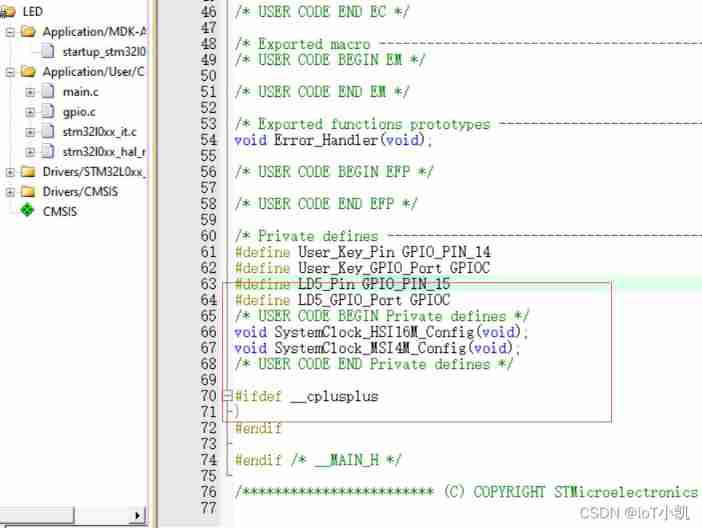
/* USER CODE BEGIN Header */
/** ****************************************************************************** * @file : main.h * @brief : Header for main.c file. * This file contains the common defines of the application. ****************************************************************************** * @attention * * <h2><center>© Copyright (c) 2022 STMicroelectronics. * All rights reserved.</center></h2> * * This software component is licensed by ST under BSD 3-Clause license, * the "License"; You may not use this file except in compliance with the * License. You may obtain a copy of the License at: * opensource.org/licenses/BSD-3-Clause * ****************************************************************************** */
/* USER CODE END Header */
/* Define to prevent recursive inclusion -------------------------------------*/
#ifndef __MAIN_H
#define __MAIN_H
#ifdef __cplusplus
extern "C" {
#endif
/* Includes ------------------------------------------------------------------*/
#include "stm32l0xx_hal.h"
/* Private includes ----------------------------------------------------------*/
/* USER CODE BEGIN Includes */
/* USER CODE END Includes */
/* Exported types ------------------------------------------------------------*/
/* USER CODE BEGIN ET */
/* USER CODE END ET */
/* Exported constants --------------------------------------------------------*/
/* USER CODE BEGIN EC */
/* USER CODE END EC */
/* Exported macro ------------------------------------------------------------*/
/* USER CODE BEGIN EM */
/* USER CODE END EM */
/* Exported functions prototypes ---------------------------------------------*/
void Error_Handler(void);
/* USER CODE BEGIN EFP */
/* USER CODE END EFP */
/* Private defines -----------------------------------------------------------*/
#define User_Key_Pin GPIO_PIN_14
#define User_Key_GPIO_Port GPIOC
#define LD5_Pin GPIO_PIN_15
#define LD5_GPIO_Port GPIOC
/* USER CODE BEGIN Private defines */
void SystemClock_HSI16M_Config(void);
void SystemClock_MSI4M_Config(void);
/* USER CODE END Private defines */
#ifdef __cplusplus
}
#endif
#endif /* __MAIN_H */
/************************ (C) COPYRIGHT STMicroelectronics *****END OF FILE****/
Observe the phenomenon
The default is PLL 24M, Press the key once, and the clock source is 16M, Press again to 4M, And then to 24M, So circular , If you observe accurately, you will find LD5 The blinking time is different ,24M Time reversal is the fastest ( Interested students can increase the delay )
边栏推荐
- MHA High available Cluster for MySQL
- 剑指 Offer 05. 替换空格
- How to copy formatted notepad++ text?
- Design a clock frequency division circuit that can be switched arbitrarily
- 实例003:完全平方数 一个整数,它加上100后是一个完全平方数,再加上168又是一个完全平方数,请问该数是多少?
- Weidongshan Internet of things learning lesson 1
- Sizeof (function name) =?
- Introduction of air gap, etc
- Semiconductor devices (III) FET
- STM32 single chip microcomputer -- volatile keyword
猜你喜欢

MySQL之MHA高可用集群
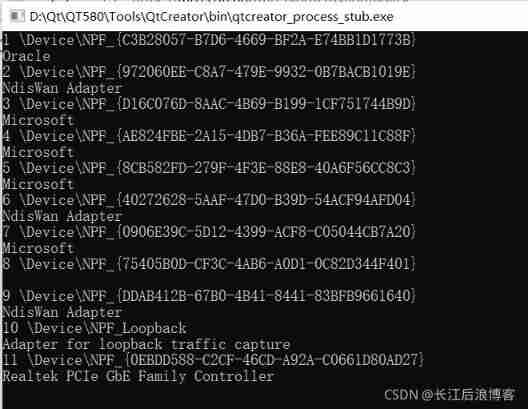
Soem EtherCAT source code analysis attachment 1 (establishment of communication operation environment)
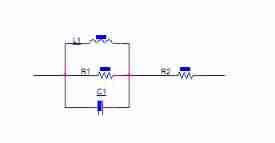
Talk about the function of magnetic beads in circuits

剑指 Offer 05. 替换空格
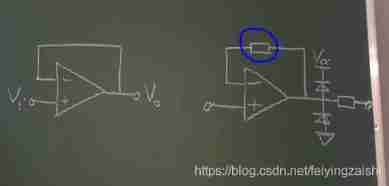
Hardware 3 -- function of voltage follower

Matlab2018b problem solving when installing embedded coder support package for stmicroelectronic
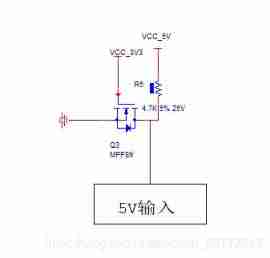
Classic application of MOS transistor circuit design (1) -iic bidirectional level shift

Arduino uses nrf24l01+ communication
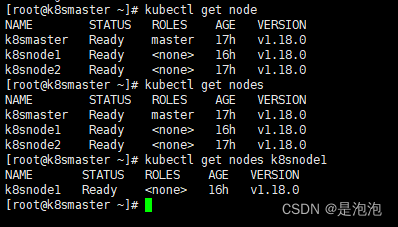
【云原生 | 从零开始学Kubernetes】三、Kubernetes集群管理工具kubectl
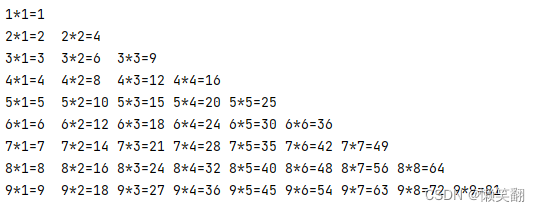
实例008:九九乘法表
随机推荐
Let's briefly talk about the chips commonly used in mobile phones - OVP chips
Relationship between line voltage and phase voltage, line current and phase current
My-basic application 1: introduction to my-basic parser
Summary -st2.0 Hall angle estimation
Soem EtherCAT source code analysis I (data type definition)
Classic application of MOS transistor circuit design (1) -iic bidirectional level shift
Soem EtherCAT source code analysis II (list of known configuration information)
Semiconductor devices (I) PN junction
Slist of linked list
[three tier architecture and JDBC summary]
Cinq détails de conception du régulateur de tension linéaire
關於線性穩壓器的五個設計細節
STM32 --- serial port communication
实例005:三数排序 输入三个整数x,y,z,请把这三个数由小到大输出。
关于线性稳压器的五个设计细节
Step motor generates S-curve upper computer
Installation and use of libjpeg and ligpng
【云原生 | 从零开始学Kubernetes】三、Kubernetes集群管理工具kubectl
Classic application of MOS transistor circuit design (2) - switch circuit design
What are the test items of power battery ul2580